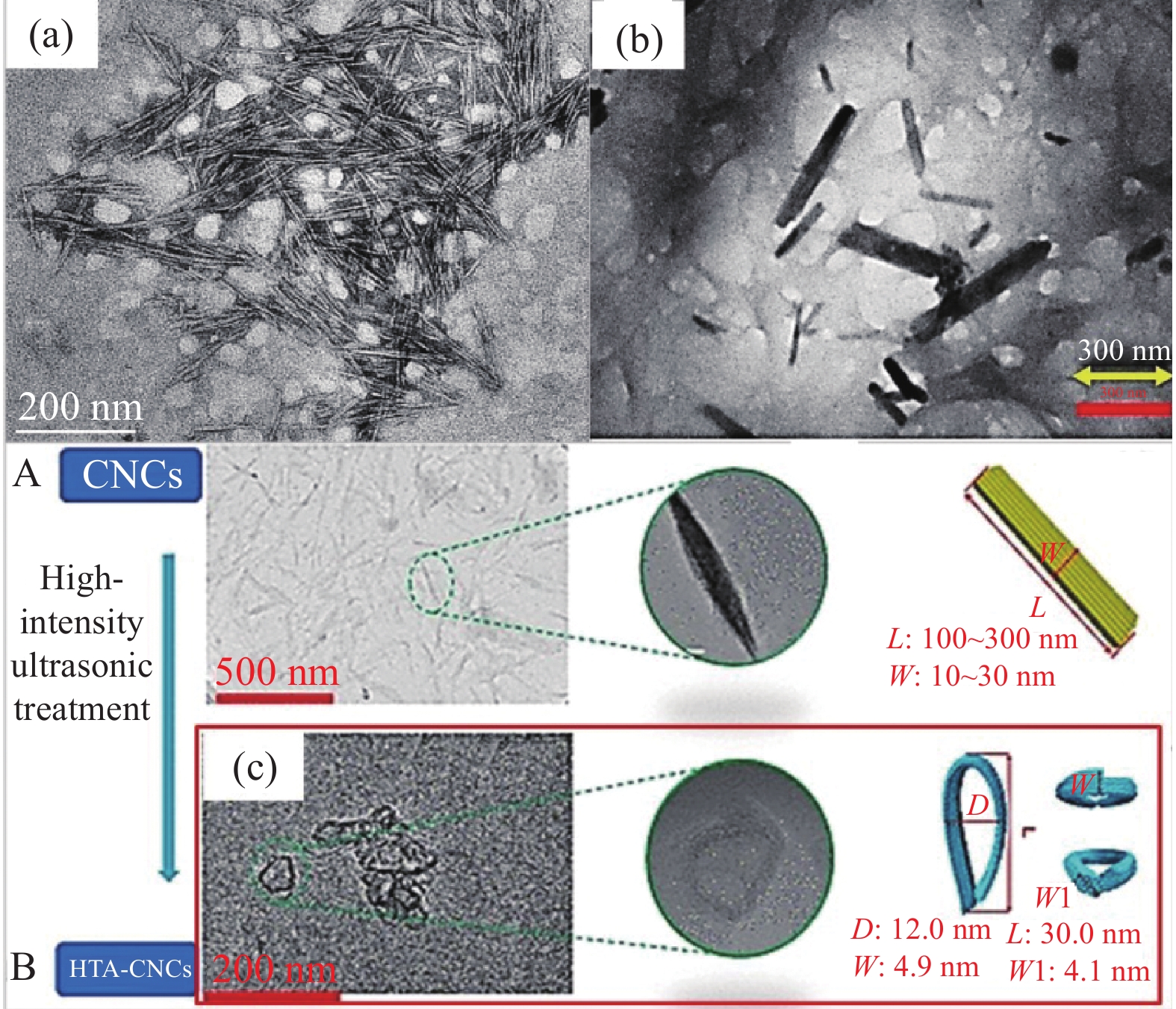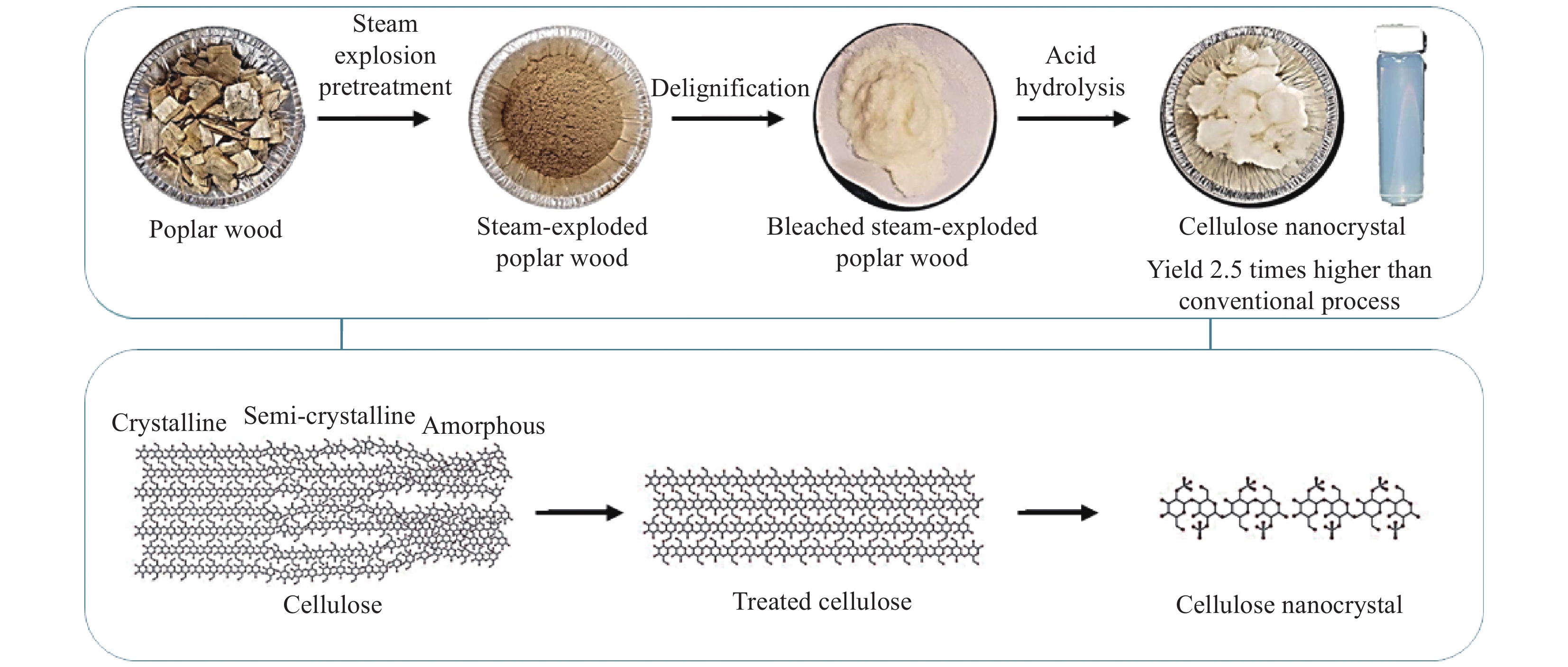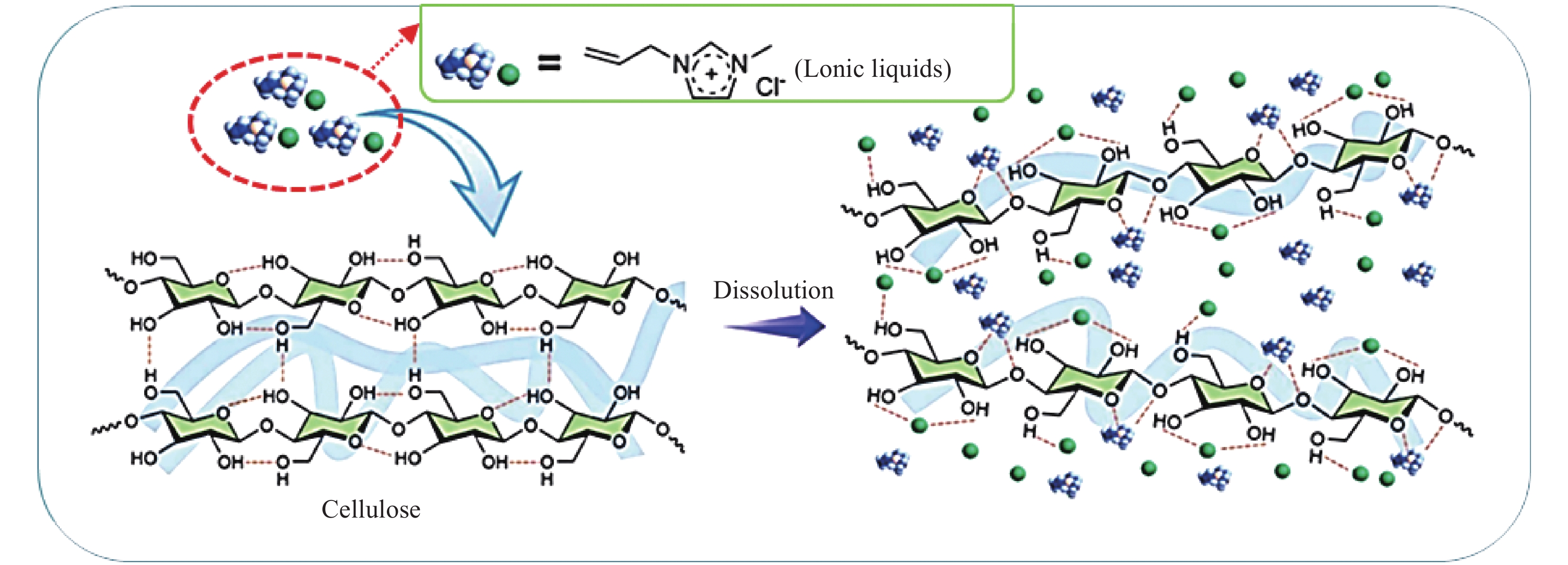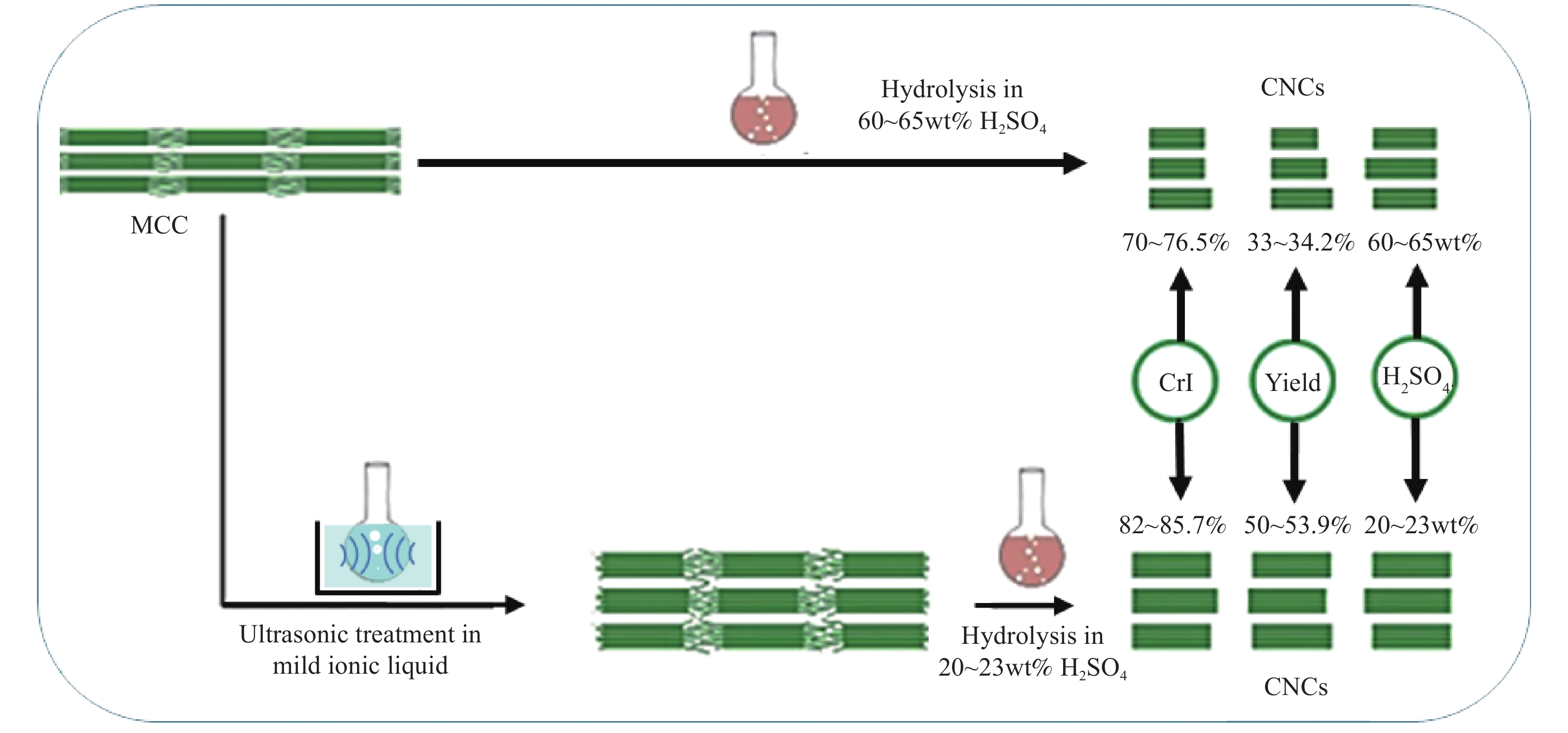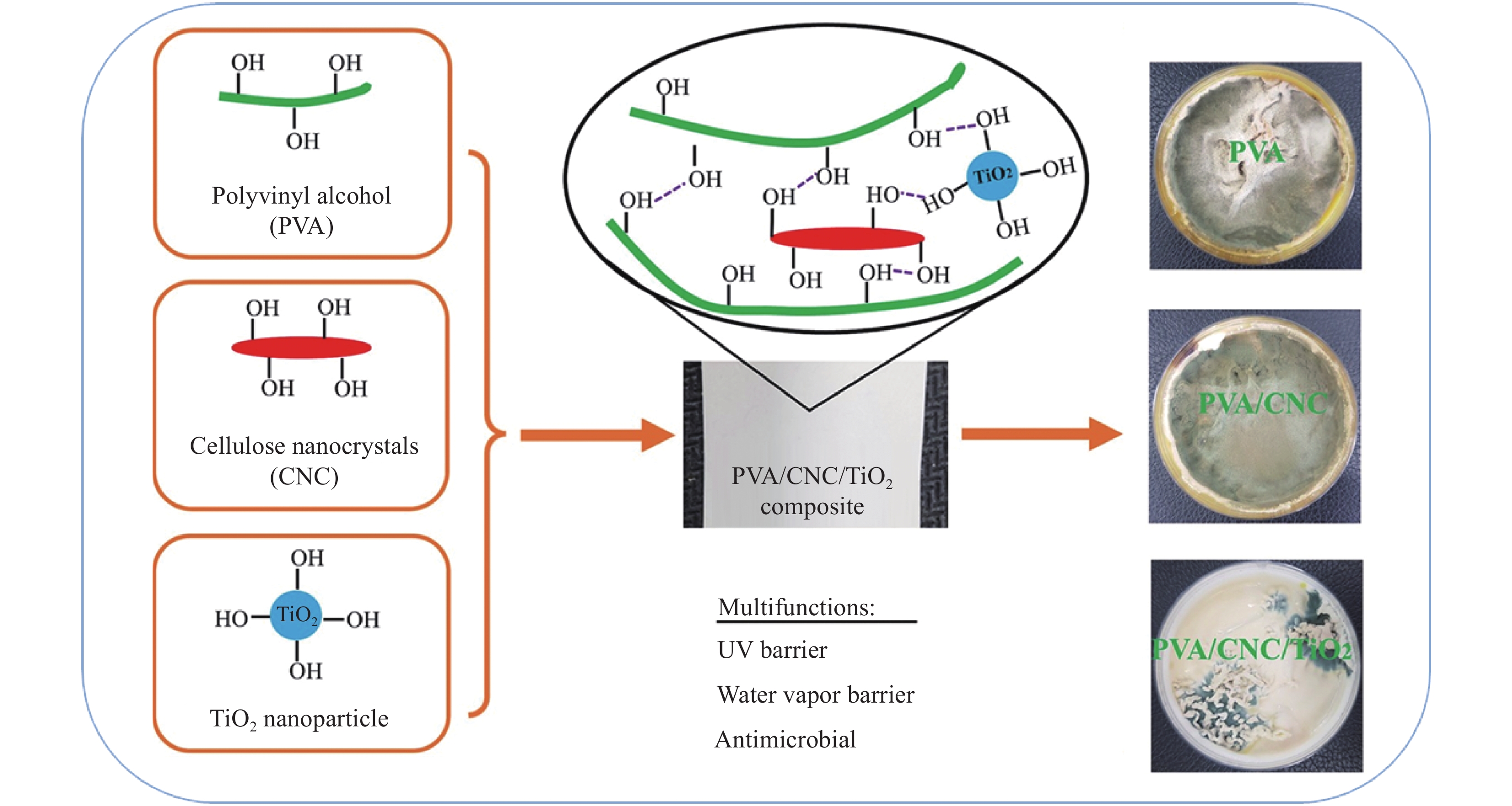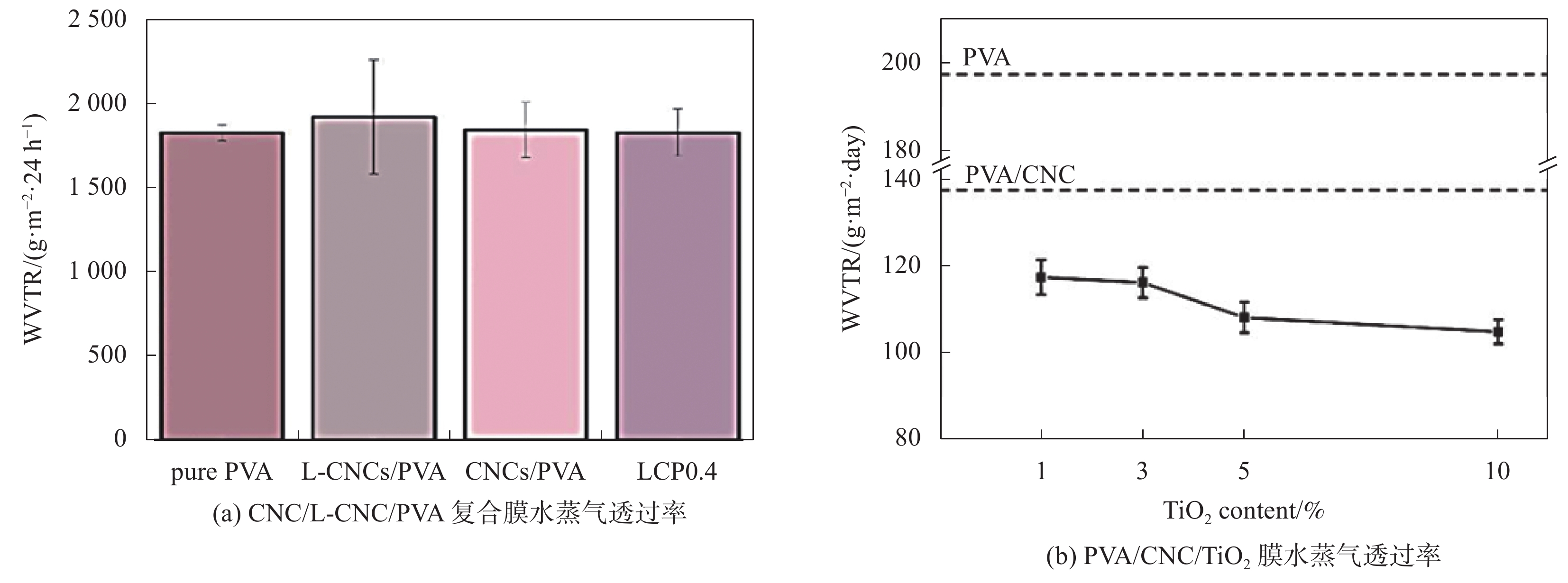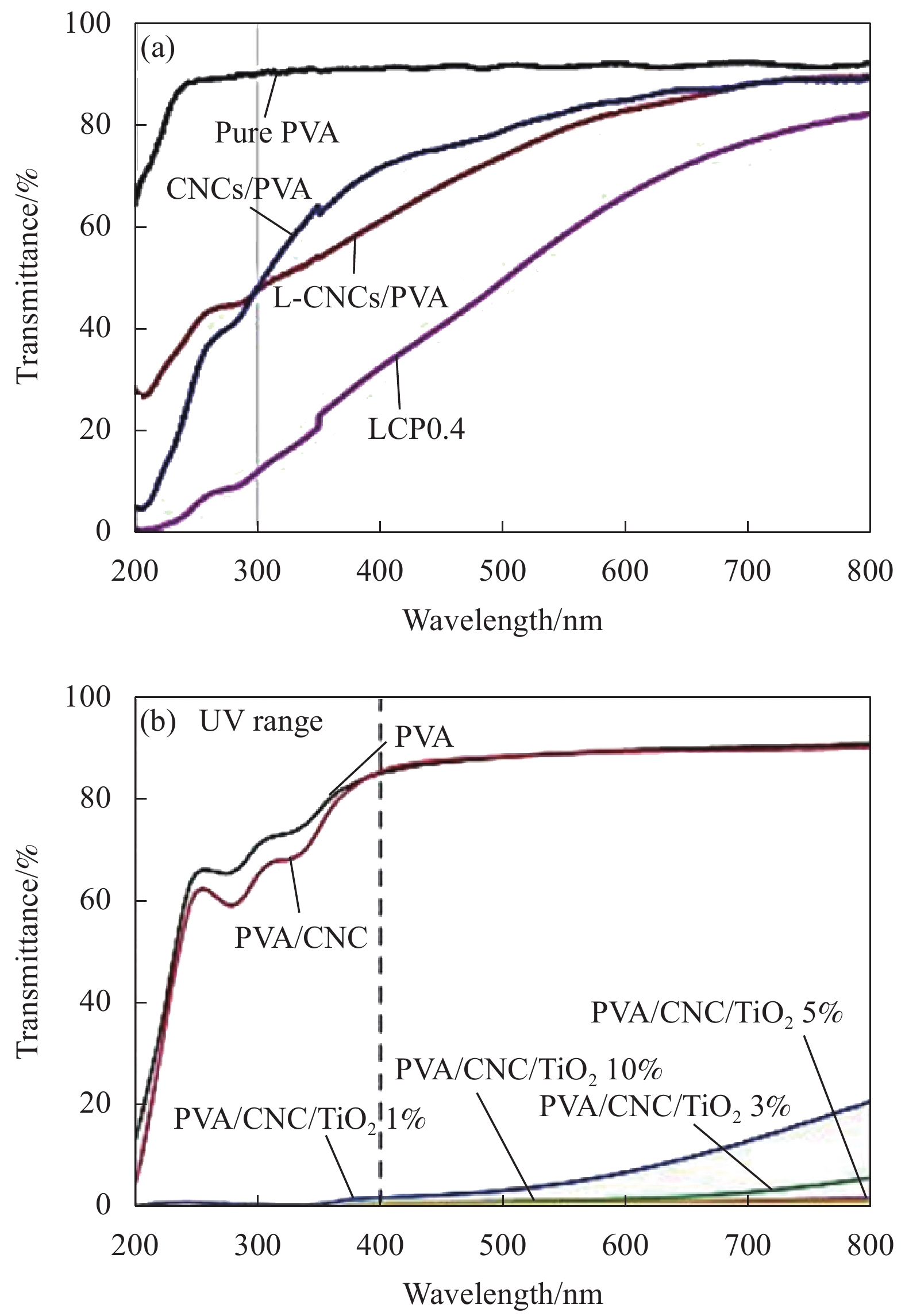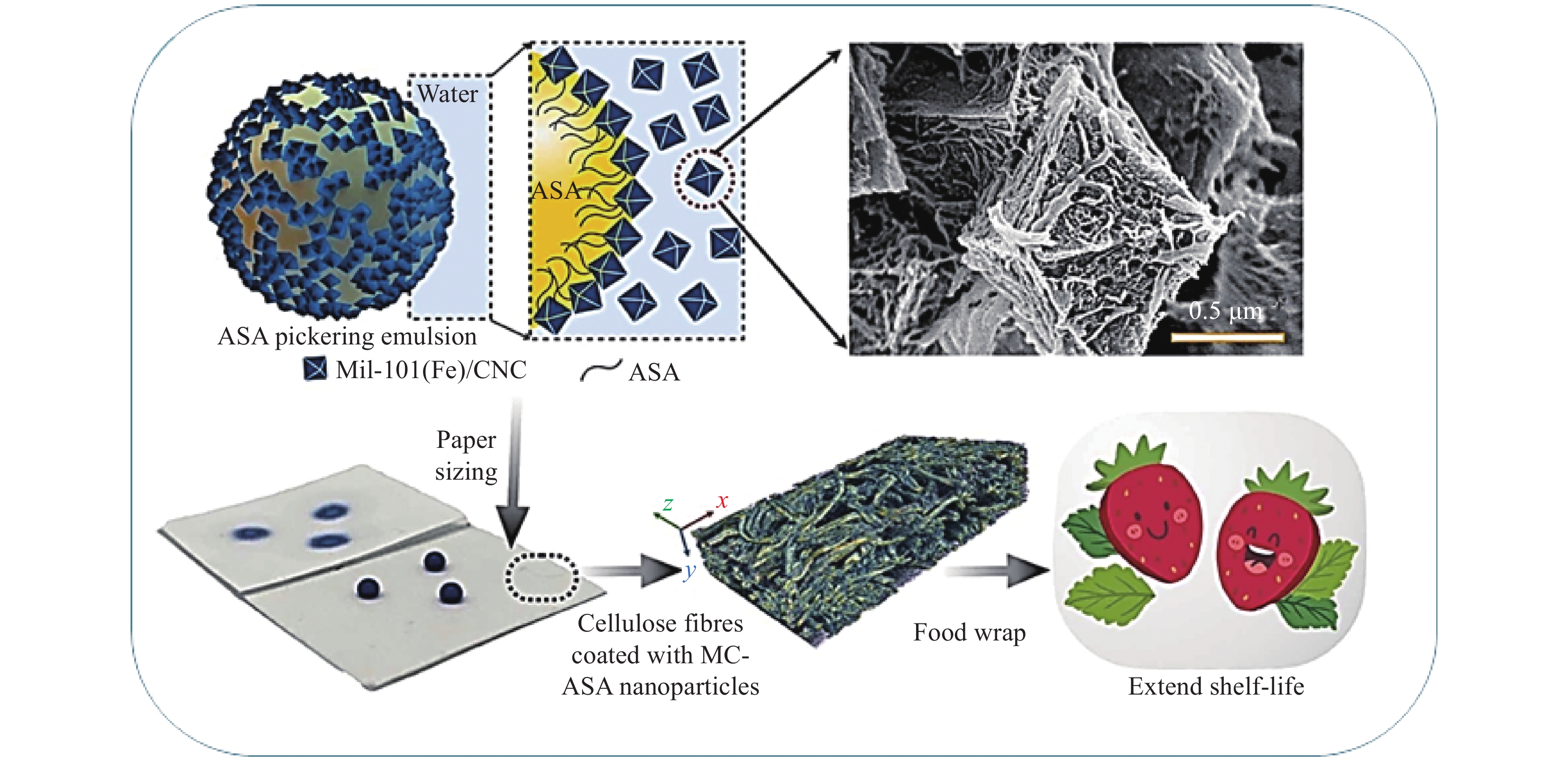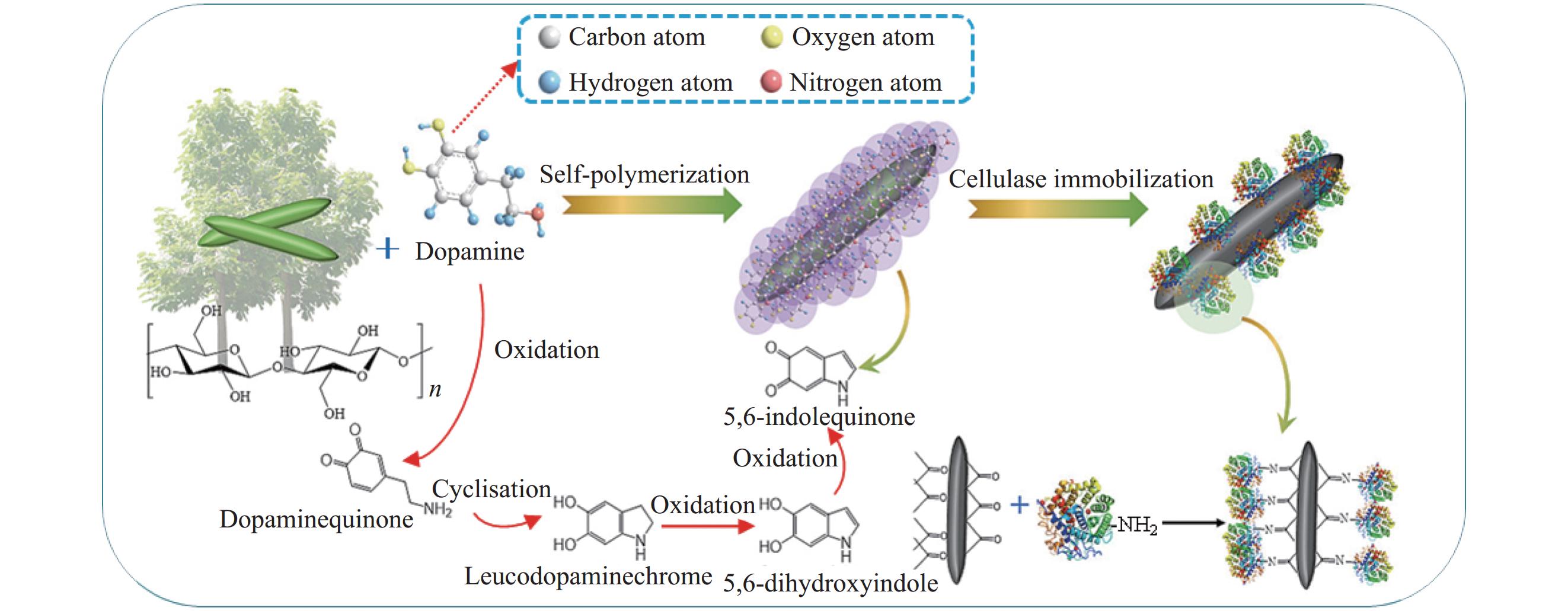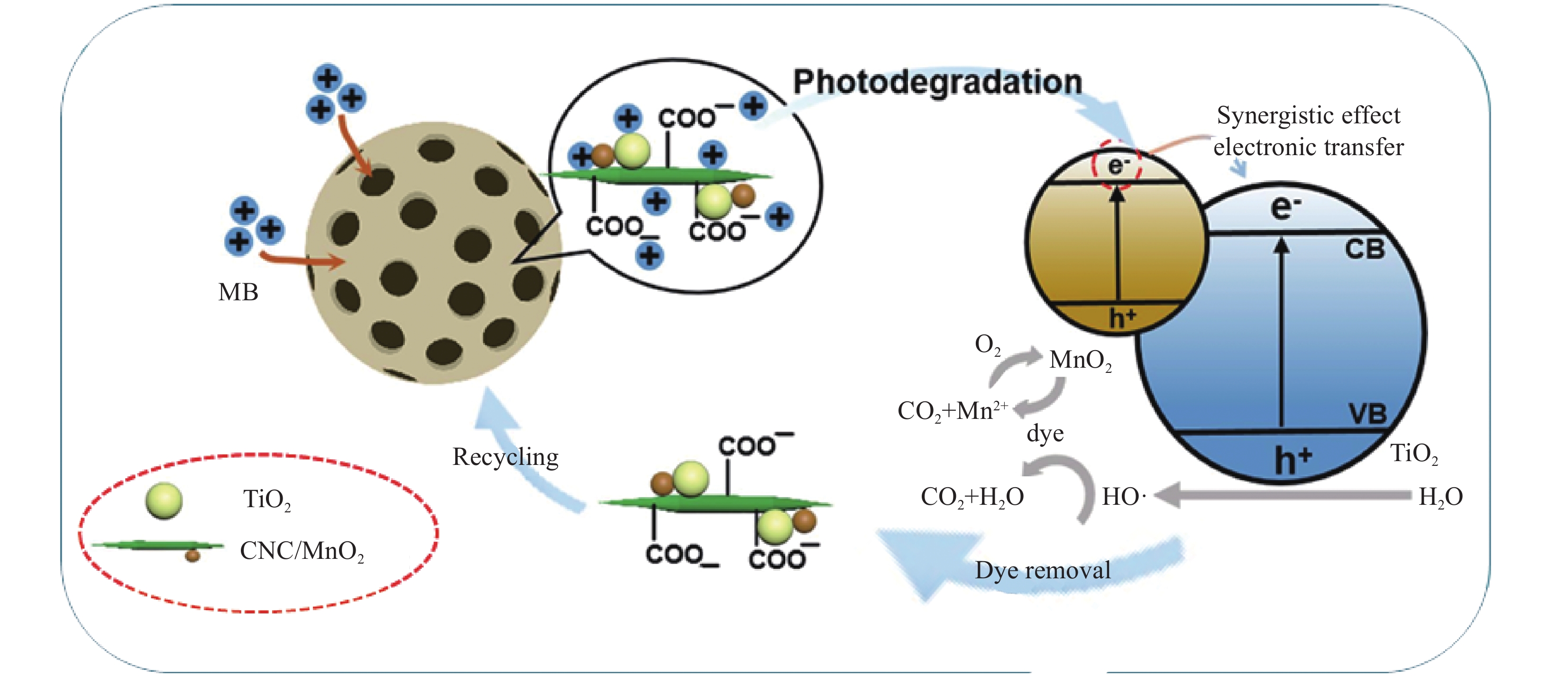Research progress of green and low consumption preparation method of cellulose nanocrystal and its application
-
摘要:
纳米纤维素是地球上最为丰富的生物质资源,具有易降解、可再生、无毒性且廉价易得等优点,纤维素纳米晶(CNC)是纳米纤维素的主要产品之一,因其高结晶度、高抗拉强度、高刚度、高比表面积等优异的理化特性,近年来受到了广泛的研究和关注。对比了传统无机酸水解法和近年来有利于节约能耗、环境友好的几种CNC新型制备方法的优缺点,介绍了CNC各新型制备方法及其优化工艺的最新研究进展,综述了CNC复合材料在食品包装、造纸行业助留助滤和纸张性能提升、固定化酶技术以及废水处理等领域的最新应用研究进展,最后,对CNC的制备方法和应用研究进行了讨论,旨在为促进CNC及其复合材料的规模化生产和推广应用提供理论参考。
-
关键词:
- 纤维素纳米晶(CNC) /
- 绿色 /
- 制备方法 /
- 应用 /
- 研究进展
Abstract:Nanocellulose is the most abundant biomass resources on the earth, with the advantages of easy degradation, renewable, non-toxic, cheap and easy to obtain.Cellulose nanocrystal (CNC) is one of the main products of nanocellulose. Due to its excellent physical and chemical properties such as high crystallinity, high tensile strength, high stiffness and high specific surface area, it has been widely studied and received extensive attention in recent years. In this paper, the advantages and disadvantages of traditional inorganic acid hydrolysis CNC preparation method and several CNC preparation methods in recent years which are beneficial to save energy consumption and be friendly to environment are compared. The latest research progress of CNC preparation methods and its optimization process is introduced. In addition, the research process of CNC composites in the field of food packaging, retention and filtration, paper performance improvement, immobilized enzyme technology and wastepaper treatment are reviewed. At last, the preparation methods and application research of CNC were discussed, aiming to provide theoretical reference for promoting the production and application scale of CNC and its composites.
-
Keywords:
- cellulose nanocrystal(CNC) /
- green /
- preparation method /
- application /
- research progress
-
目前,全球变暖带来的负面效应极大地影响了人类的生产生活[1-2],能源的过度消耗和匮乏使得环境问题进一步增加,如何做好热管理是目前面临的主要问题[3-5]。地球表面温度为300 K,而外太空平均温度为3 K[6-7],根据热力学第二定律,地球上物体的热量由于热量差可以通过辐射的方式将热量传递到外太空。因此,辐射制冷技术是地球上的物体通过“大气窗口”波段(8~13 μm)将热量辐射到外太空[8-10],以此实现自身降温冷却的过程。
虽然辐射制冷材料在节能环保方面显示出极大的应用潜力[10],但现有材料多为白色或银白色,外观单调,利用率极低。染料会使材料的表面颜色发生改变,但染料的可见色会吸收热量,并在近红外波段内吸收额外的热量[11-12],降低了材料本身的制冷效果。到目前为止,克服这一问题的主要策略是提高在可见光区域内的反射率和在“大气窗口”波段(8~13 μm)的发射率[13-16]。为避免染料吸收热量的现象,结构色辐射制冷材料引发人们的广泛关注[17-18]。利用硅蛋白石可以制备具有结构色变化的辐射制冷材料,但这种方法不能实现亚环境冷却[19],并且生产工艺和条件复杂且苛刻,很难进行大批量生产和应用。
纤维素纳米晶体(CNC)是刚性的棒状颗粒,长度为数十至数百纳米,直径可以达到数十纳米[20],具有结晶度高、降解性好等特点。CNC可以从棉花、木材和纸浆等可再生资源中提取,具有成本低、绿色、可持续等特性[21-23]。CNC可以在水中自发地组织成手性向列结构的液晶相,这种有序结构在干燥过程中可以得到保留,直至得到具有手性向列结构的CNC薄膜[24]。双折射的CNC纳米棒在薄膜中呈现的螺旋式排列会使纳米结构的折射率产生周期性的变化,进而引起对可见光的强烈反射[25]。因此,结构色的调节与螺旋结构的周期性密切相关。
目前已有研究致力于制造色彩更为丰富的纤维素辐射制冷材料。Shanker等[26]通过将CNC自组装成结构色薄膜,与硅片基底结合,得到了一种结构色辐射制冷装置。通过控制CNC/甘油(GLU) 的质量比得到颜色由蓝紫色转变为红色的复合薄膜。结构色复合薄膜表现出在太阳光谱范围内低吸收率和“大气窗口”内高发射率,且绿色和红色样品降温效果可达9℃左右,蓝紫色样品的降温效果可达6℃左右,为制备纤维素结构色辐射制冷薄膜提供了研究基础。
本文将CNC与聚乙二醇(PEG)复合,通过自组装方法制备了高太阳光反射率和在“大气窗口”波段高发射率的结构色薄膜。通过控制CNC与PEG的质量比,调控复合薄膜的结构色,以实现不同波段的热辐射率调控。探究不同含量PEG的添加对CNC复合结构色薄膜的结构、光学性能及制冷性能的影响。并将复合结构色薄膜粘贴到醋酸纤维素滤膜上制备成双层复合膜,进一步探究双层复合膜的辐射制冷效应。
1. 实验材料及方法
1.1 原材料
醋酸纤维素:上海兴亚净化材料厂;浓硫酸(H2SO4):分析纯,阿拉丁世纪有限公司;聚乙二醇400:分析纯,天津市科密欧化学试剂有限公司。
1.2 实验过程
CNC的制备:利用酸水解法制备CNC,将200 mL 64%硫酸溶液缓慢倒入25 g硫酸盐漂白针叶浆中,在45℃的水浴加热中搅拌1 h,后加入大量蒸馏水来终止水解反应。静置2~3 d,去除上清液,加入去离子水通过高速离心机 (CT14D型,上海天美仪器有限公司) 进行多次离心洗涤。得到的CNC悬浮液,将CNC在去离子水中透析,直至pH为中性。最后将CNC悬浮液浓缩至3wt%,冷藏备用。
CNC/PEG复合薄膜的制备:称取聚乙二醇5.0 g,加入45 g超纯水中,在室温搅拌1 h,得到质量分数10wt%的聚乙二醇溶液。取一定量的质量分数为3wt%的CNC悬浮液超声5 min,取4份3.0 g CNC悬浮液分别与
0.1000 g、0.2250 g、0.3857 g和0.6000 g PEG的溶液进行混合,将上述溶液充分搅拌2 h,后将混合液体倒入圆形容器中,室温缓慢蒸发2~3 d,得到PEG浓度为10wt%、20wt%、30wt%和40wt%的CNC/PEG复合结构色薄膜。按照聚合物的种类和含量对复合薄膜进行命名,分别为CNC/PEG-10%、CNC/PEG-20%、CNC/PEG-30%、CNC/PEG-40%,具体见表1。表 1 纤维素纳米晶体/聚乙二醇(CNC/PEG)复合辐射制冷薄膜和CNC/PEG-醋酸纤维素(CA)结构色辐射制冷双层复合膜的命名Table 1. Naming of cellulose nanocrystal/polyethylene glycol (CNC/PEG) composite radiative cooling films and CNC/PEG-cellulose acetate (CA) structure-colored radiation-cooled bilayer composite filmsSample Mass fraction of
CNC/wt%Mass fraction of
PEG/wt%CA CNC/PEG-10% 3 10 — CNC/PEG-20% 3 20 — CNC/PEG-30% 3 30 — CNC/PEG-40% 3 40 — CNC/PEG-10%-CA 3 10 0.0740 g CNC/PEG-20%-CA 3 20 0.0740 g CNC/PEG-30%-CA 3 30 0.0740 g CNC/PEG-40%-CA 3 40 0.0740 g 双层复合膜的制备:将不同质量比的复合结构色薄膜与醋酸纤维素膜用双面胶粘在一起,双面胶放在醋酸纤维素膜的边缘起固定作用,不会影响双层复合结构色薄膜的结构,双层复合结构色薄膜分别命名为CNC/PEG-10%-CA、CNC/PEG-20%-CA、CNC/PEG-30%-CA,具体见表1。
1.3 测试与表征
1.3.1 CNC/PEG复合膜的性能分析
采用Malvern Zetasizer nano ZS90测试CNC的Zeta电位和粒径。利用偏光显微镜(POM,XPF-550C,上海蔡康光学仪器公司)观察复合薄膜样品的液晶特性。使用反射光谱仪(UV-vis,HR4000 CG-NIR型,海洋光学公司)对薄膜进行反射光谱测试(可见光区域)。将复合薄膜用液氮进行脆断,用双面导电胶粘到截面制样台上,喷金60 s,利用扫描电子显微镜(SEM,JSM-7500F,日本电子株式会社)观察复合薄膜的横截面微观形貌。使用带有积分球附件的紫外-可见-近红外分光光度计(UV-VIS-NIR Spectrometer,美国Perkins Elmer公司)检测样品在300~
2500 nm波长范围内的反射率变化。利用傅里叶变换红外光谱仪(FTIR,Nicolet-IS10,美国Thermo Fisher公司)检测样品在2.5~25 μm的波长范围内样品的吸收率变化。采用太阳光谱匹配良好的高功率氙灯(中教金源HXF300)来模拟太阳光照射,在聚苯乙烯(PS)泡沫箱子中裁剪一个1 cm×1 cm×1 cm的空腔,将薄膜或复合薄膜放置在空腔中固定,利用聚乙烯薄膜覆盖泡沫箱,消除环境热对流影响。将多通道温度计(JINKO,JK804)与两个k型热电偶进行连接,一个k型热电偶测试复合薄膜覆盖下空腔的内部温度,另一个k型热电偶用来测量聚乙烯膜覆盖下的装置内的环境温度。由于CNC/PEG-40%复合薄膜在表征过程中会吸收环境的水分,手性结构发生润胀,螺距在实际测量中会发生变化,不利于复合薄膜在实际环境中的应用,因此后续将不会对CNC/PEG-40%复合薄膜进行扫描电镜、光谱学和辐射制冷性能的测试与分析。1.3.2 双层复合膜的性能分析
将醋酸纤维素膜用导电胶粘贴到水平制样台上,喷金60 s,利用扫描电子显微镜观察醋酸纤维素薄膜的表面形貌。在同一氙灯光源照射下,观察不同样品在红外热成像仪(FTIR-E390,美国FLIR SYSTEMS公司)下的温度变化。利用上述自组装装置分别测量双层复合薄膜下方温度及被聚乙烯膜覆盖的整个装置内的环境温度。利用实验室自组装装置对样品进行户外降温性能测试,将室内自组装降温性能测试装置放置在用铝箔纸包裹的纸壳箱中,整体放置在泡沫箱上,用湿度计记录测试过程中的环境湿度变化。
2. 结果与讨论
2.1 纤维素纳米晶的电位粒径分析
图1为CNC的TEM图像、粒径分布和电位曲线,酸水解法制备的CNC具有棒状形态,平均粒径为144.1 nm (图1(b))。在水解过程中,CNC表面形成较多的负电荷,Zate电位高达−32.2 mV (图1(c))。CNC表面较多的负电荷会促进静电排斥作用,使CNC溶液的稳定性增强,为进一步制备结构色复合薄膜奠定基础。
2.2 纤维素纳米晶复合薄膜结构色光学特性分析
图2(a)~2(d)是PEG含量不同的复合薄膜光学照片。随着PEG含量的增加,薄膜反射颜色发生红移,逐渐由蓝绿色转变为红色。因此,复合薄膜的结构色红移现象与PEG的含量相关。通过对紫外-可见反射光谱(图2(e))分析可得,随着PEG含量的增加,4种复合薄膜分别在427 nm、487 nm、576 nm和654 nm处存在清晰的高峰,复合薄膜反射光谱中的最高峰发生红移,与薄膜结构色的红移相对应。通过图2(f)可知,复合薄膜通过反射可见光和发射热量来实现自身降温,为后续辐射制冷的研究提供理论基础。
2.3 纤维素纳米晶复合薄膜微观形貌分析
图3(a)~3(c)为PEG含量不同复合薄膜的横截断面扫描电镜图。当PEG含量为40%时,复合薄膜会吸收环境中的水分,手性结构发生润胀,螺距在实际测量中会发生变化,因此只对PEG含量为10%~30%的CNC/PEG复合薄膜进行扫描电镜的研究,不对CNC/PEG-40%复合薄膜进行扫描电镜的测试与分析。纯CNC薄膜具有周期性的层状结构,CNC通过逆时针方向旋转后形成了左旋的手性向列螺旋结构,这种左旋的手性向列结构反射特定波长的左旋圆偏振光,从而使复合薄膜表现出独特的虹彩色。聚合物的加入并不会改变CNC原有的手性向列结构,随着聚合物含量的增加,CNC手性向列结构的螺距明显增加。布拉格方程式中手性向列的螺距(P)定义为CNC棒状颗粒旋转360°产生的层间距,在电镜图(SEM)中表现为相邻两层结构的间距。
CNC/PEG复合薄膜的反射光遵循布拉格方程:
λ=nPcos(θ) (1) 其中:λ为反射波长;n为薄膜的平均折射率;θ为入射角;P为手性向列结构的层间距。因为CNC和PEG的折射率相似,分别为1.41和1.44,所以薄膜的平均折射率(n)可以认为是常量,当入射角(θ)恒定时,λ取决于手性向列结构的螺距P。图3(a)~3(c)的平均螺距分别为0.30、0.36和0.46 μm。随着平均螺距P的增加其反射波长λ也逐渐增大,主要原因是在加入PEG后,PEG高分子进入到CNC手性向列结构中,导致CNC手性向列结构的螺距P增大,复合薄膜颜色红移。
2.4 纤维素纳米晶复合薄膜折射现象
图4是PEG含量不同的复合薄膜偏光显微镜(POM)图像。通过观察图4(a)~4(d)可以得知薄膜具有明显的双折射现象,高倍POM图像(图4(e)~4(h))可以看出其具有明显的指纹结构,这说明CNC/PEG在干燥过程中CNC自组装了手性向列结构,并且在完全成膜后,仍然保留其手性向列结构。因此,适量PEG的加入并不会破坏CNC自组装所形成的手性向列结构。复合薄膜的指纹结构的纹理间隔随着PEG含量的增加逐渐变宽,分别为2.05 μm、2.33 μm、2.84 μm和3.38 μm,颜色由蓝绿色逐渐转化成蓝红色。PEG的添加占据了手性向列结构CNC之间的空间,导致螺距P增大,从而发生红移。因此,通过对POM结果分析,证明了PEG的添加不会破坏CNC的手性向列结构和双折射现象,控制PEG含量可以有效调控CNC手性向列层间距,进而调控复合薄膜结构色的变化。
2.5 纤维素纳米晶结构色复合薄膜和双层复合薄膜的光谱学分析
由基尔霍夫定律可知,样品的发射率(T)等同于吸收率(A)。通过观察图5(a)可知,在室内湿度为42%时,样品在大气窗口波段(8~13 μm)都有较高的发射率,其中当PEG的含量为30%时,复合薄膜的发射率最高可达93.0%,这样可以最大限度的向天空辐射红外热量。CNC/PEG复合薄膜具有高发射率,这是由于O—H (6.9~7.6 μm)、C—O (7.6~9.5 μm)、C—H (11.1~14.3 μm)键在大气窗口范围(8~13 μm)内产生强烈的拉伸与弯曲振动所导致的。图5(b)是PEG含量不同的复合薄膜在太阳波段(0.3~2.5 μm)范围内太阳光反射率曲线,结构色复合薄膜在近红外范围内的反射率最高可达68.5%。随着PEG的含量增加,其反射率也随之变高。
图6为不同PEG含量的双层复合制冷膜的发射率曲线和在可见光范围内的反射率曲线。通过观察图6(a)可知,在室内湿度为42%的测量环境下,双层复合膜在大气窗口的发射率高于醋酸纤维素膜的发射率,随着PEG含量的增加双层复合膜的发射率也逐步提高,当PEG含量为30%时,双层复合膜的发射率最高可达68.0%。图6(b)是PEG含量不同的双层复合膜在太阳波段(0.3~2.5 μm)范围内的太阳光反射率曲线,在近红外范围内的反射率最高可达91.8%。
2.6 纤维素纳米晶复合结构色薄膜和双层复合薄膜的辐射制冷性能分析
图7(a)为室内氙灯模拟图,利用100 mW/cm2高功率氙灯来照射,不仅可以模拟太阳光照射还可以将光均匀地分布在样品表面。图7(b)为用来测量样品温度及装置内空气温度的自组装装置,聚乙烯(PE)薄膜既可以保证氙灯的光照射到装置内部,又可以减少热对流对辐射制冷结果的影响。由图7(c)、图7(d)可知,将氙灯打开后,PE薄膜覆盖的装置内部温度迅速上升,在5 min后样品逐渐达到热稳定状态。当温度逐渐趋向平衡时,薄膜下方温度明显低于PE覆盖装置内的空气温度,不同结构色CNC/PEG复合薄膜辐射制冷性能相似,薄膜平均降温可达3.4℃。
![]() 图 7 (a)室内氙灯模拟装置图;(b)自组装温度测量装置图;CNC/PEG-10%和空气(c)、CNC/PEG-30%和空气(d) 温度对比图Figure 7. (a) Photos of indoor xenon lamp simulation device; (b) Self assembling temperature measuring device; Temperature comparison of CNC/PEG-10% and air (c), CNC/PEG-30% and air (d)PE—Polyethylene; IR—Infrared spectroscopy
图 7 (a)室内氙灯模拟装置图;(b)自组装温度测量装置图;CNC/PEG-10%和空气(c)、CNC/PEG-30%和空气(d) 温度对比图Figure 7. (a) Photos of indoor xenon lamp simulation device; (b) Self assembling temperature measuring device; Temperature comparison of CNC/PEG-10% and air (c), CNC/PEG-30% and air (d)PE—Polyethylene; IR—Infrared spectroscopy图8(a)~8(c)为不同纤维素基底在同一光源照射下的红外热成像图。在氙灯的照射下,采用红外热成像观察5 min,可以看出,醋酸纤维素薄膜的表面温度最低,滤纸的表面温度略高于醋酸纤维素薄膜,而A4纸的表面温度最高。通过观察醋酸纤维素的SEM图像(图8(d))可知,醋酸纤维素膜具有多孔结构,可以有效地反射可见光。图8(e)为醋酸纤维素膜下温度与环境温度对比曲线,膜下温度平均比环境温度低15℃左右。综上表明,醋酸纤维素薄膜具有良好的辐射降温能力,是作为双层复合薄膜的较优选择。
利用红外热成像分别观察CNC/PEG-20%、CNC/PEG-20%-CA和带有蓝色涂料的CA薄膜在相同时间和相同光照下其表面的降温能力,如图9(a)~9(c)所示。结果可知,CNC/PEG-20%-CA的表面降温能力较强,CNC/PEG-20%的降温能力次之,而带有蓝色涂料的CA薄膜的表面降温能力最差。通过分析CNC/PEG-20%和带有蓝色涂料的CA薄膜的温度曲线(图9(d)、图9(e)),进一步证实双层复合薄膜具有良好的制冷性能。由图9(f)、图9(g)可知,PE薄膜覆盖下装置内的空气温度与双层复合制冷膜下方温度的起始温度大致相同,氙灯打开后,两者温度迅速上升,5 min后双层复合制冷膜下方温度与装置内空气温度逐渐达到热稳定状态。当温度逐渐趋向平衡时,双层复合制冷膜下方温度远低于装置内空气温度,双层复合膜的辐射制冷性能几乎不受PEG含量的影响,双层复合薄膜平均降温可达14.3℃,双层复合膜的降温性能优于复合薄膜的降温性能。实验结果表明:CNC/PEG复合薄膜平均可降温3.4℃左右,醋酸纤维素膜是作为双层复合膜的理想基底,双层复合制冷膜的降温性能优于复合薄膜,平均降温可达14.3℃左右。
![]() 图 9 ((a)~(c)) CNC/PEG-20%、CNC/PEG-20%-CA与带有蓝色涂料的CA薄膜红外热成像图;带蓝色涂料的CA和空气(d)、CNC/PEG-20%-CA和空气(e)、CNC/PEG-10%-CA和空气(f)、CNC/PEG-30%-CA和空气(g)温度对比图Figure 9. ((a)-(c)) Infrared thermograms of CNC/PEG-20%, CNC/PEG-20%-CA and and CA films with blue coatings; Temperature comparison of CA with blue painting and air (d), CNC/PEG-20%-CA and air (e), CNC/PEG-10%-CA and air (f), CNC/PEG-30%-CA and air (g)
图 9 ((a)~(c)) CNC/PEG-20%、CNC/PEG-20%-CA与带有蓝色涂料的CA薄膜红外热成像图;带蓝色涂料的CA和空气(d)、CNC/PEG-20%-CA和空气(e)、CNC/PEG-10%-CA和空气(f)、CNC/PEG-30%-CA和空气(g)温度对比图Figure 9. ((a)-(c)) Infrared thermograms of CNC/PEG-20%, CNC/PEG-20%-CA and and CA films with blue coatings; Temperature comparison of CA with blue painting and air (d), CNC/PEG-20%-CA and air (e), CNC/PEG-10%-CA and air (f), CNC/PEG-30%-CA and air (g)图10(a)、图10(b)为测量CNC/PEG-30%-CA、CNC/PEG-30%及PE覆盖装置内空气温度的户外装置图,利用铝箔纸包裹整个装置以减少周围建筑物对装置热辐射的影响,在装置顶部覆盖一层PE膜来减少环境中的热对流及热传导对整个装置的影响,装置下方的泡沫箱用来隔绝地面对测量温度的热影响,利用热电偶分别记录样品覆盖空腔中的温度及PE膜覆盖下装置的空气温度。通过分析图10(c)可以看出,在平均温度为25℃,平均湿度51%的户外环境中,与PE覆盖装置中空气温度对比,复合薄膜可以实现平均2℃左右的降温效果,而双层复合薄膜可以实现平均6℃左右的降温效果。
![]() 图 10 ((a), (b))测试CNC/PEG-30%-CA、CNC/PEG-30%和空气的温差变化的户外装置图;(c) CNC/PEG-30%-CA、CNC/PEG-30%与空气的温差图Figure 10. ((a), (b)) Diagram of an outdoor installation for testing the change in temperature difference between CNC/PEG-30%-CA, CNC/PEG-30% and air; (c) Temperature comparison of CNC/PEG-30%-CA, CNC/PEG-30% and air
图 10 ((a), (b))测试CNC/PEG-30%-CA、CNC/PEG-30%和空气的温差变化的户外装置图;(c) CNC/PEG-30%-CA、CNC/PEG-30%与空气的温差图Figure 10. ((a), (b)) Diagram of an outdoor installation for testing the change in temperature difference between CNC/PEG-30%-CA, CNC/PEG-30% and air; (c) Temperature comparison of CNC/PEG-30%-CA, CNC/PEG-30% and air3. 结 论
本文将纤维素纳米晶体(CNC)与聚乙二醇(PEG)以不同比例混合,采用自组装的方法制备了具有辐射制冷性能的结构色复合薄膜,将结构色复合薄膜与具有多孔结构的醋酸纤维素膜(CA)相结合,制备具有辐射制冷和结构色特性的双层复合膜。分别对复合薄膜和双层复合膜的性能进行分析,得出的结论如下:
(1) CNC/PEG复合薄膜具有手性向列结构和鲜艳的结构色,复合薄膜出现明显的双折射特性,随着PEG含量的增加,复合薄膜手性向列结构的螺距增大,反射波长随之发生红移,最终导致薄膜结构色的变化;
(2)对CNC/PEG复合薄膜和CNC/PEG-CA双层复合膜进行FTIR和UV-vis测试可知,复合薄膜在0.25~2.5 μm的波长范围内的反射率高达93.0%,双层复合膜反射率可达68.0%,复合薄膜在“大气窗口”(8~13 μm)范围内的发射率可达68.5%,双层复合膜发射率高达91.8%;
(3)在氙灯照射下,CNC/PEG结构色复合薄膜具有辐射制冷性能,与装置内空气温度对比,平均降温可达3.4℃左右。与具有多孔结构的醋酸纤维素膜结合,双层结构色复合薄膜的辐射制冷性能得到提升,平均降温可达14.3℃左右。在户外降温性能测试中,复合薄膜可以达到平均2℃左右的降温效果,双层复合膜可以达到平均6℃左右的降温效果。
-
表 1 CNC基本特性的最新研究
Table 1 Latest research on basic performance of CNC
Name/parameters Type/value Material source wood[15] cotton fiber[16,17] agricultural waste[18,19] microcrystalline cellulose[20] tunicate[21] waste paper[23] Mean length/nm 93±26[36] 168±71[37] 260±180[16,19,20,23] 370±150[33] Length-diameter ratio 5~55[20,34,36] Mean diameter/nm 3~5[35] 5.72[20] 19±11[37] 34±9[16] 30±20[32,33] 53.9[23] Zeta potential of the aqueous suspension/mV −38.6[19] 49.3[16] 53.5[20] Surface charge density/e·nm−2 0.29±0.01[35] Crystallinity/% 54~88[25] 73[23] 76.7[32] 78.00[31] 79.00[30] 84.02[26] 89.9[16] 91.8~97.8[36] Tensile strength/MPa 7500 [27]Transverse elastic moduli/GPa 18~50[38] Longitudinal elastic moduli/GPa 140~220[23,28] 表 2 BmimCl和AmimCl的基本性能特点
Table 2 Basic performance characteristics of BmimCl and AmimCl
Name Parameter BmimCl AmimCl Synthesis time/h 48 80%(3 h conversion rate)
100%(6 h conversion rate)Initial decomposition temperature/℃ 254 273 Viscosity at 30℃/(mPa·s) 685 11000 -
[1] 杨淑蕙. 植物纤维化学[M]. 北京: 中国轻工业出版社, 2009: 163. YANG Shuhui. Plant fiber chemistry[M]. Beijing: China light industry press, 2009: 163 (in Chinese).
[2] FAROOQ A, JIANG S, FAROOQ A, et al. Structure and properties of high quality natural cellulose nano fibrils from a novel material Ficus natalensis barkcloth[J]. Journal of Industrial Textiles, 2021, 51(4): 664-680. DOI: 10.1177/1528083719887533
[3] NAEEM M A, LV P F, ZHOU H M, et al. A novel in situ self-assembling fabrication method for bacterial cellulose-electrospun nanofiber hybrid structures[J]. Polymers, 2018, 10(7): 712. DOI: 10.3390/polym10070712
[4] DYLAN L, SANDEEP A, KAMAL K. Nanocellulose-based polymer composites for energy applications-A review[J]. Journal of Applied Polymer Science, 2020, 137(27): 48959. DOI: 10.1002/app.48959
[5] JU S, LEE A, SHIN Y, et al. Preventing the Collapse behavior of polyurethane foams with the addition of cellulose nanofiber[J]. Polymers, 2023, 15(6): 1499. DOI: 10.3390/polym15061499
[6] TURBAK A, SNYDER F, SANDBERG K. Microfibrillated cellulose, a new cellulose product: properties, uses, and commercial potential[J]. Journal of Applied Polymer Science, 1983, 37: 815-827.
[7] WANG Q Q, YAO Q, LIU J, et al. Processing nanocellulose to bulk materials: a review[J]. Cellulose, 2019, 26(13-14): 7585-7617. DOI: 10.1007/s10570-019-02642-3
[8] DO T V V, TRAN N B A, NGUYEN-THAI N U. Preparation of spherical nanocellulose from Gai bamboo and mechanical properties of chitosan/nanocellulose composite Preparation of spherical nanocellulose from Gai bamboo and mechanical properties of chitosan/nanocellulose composite[J]. Polymer Composites, 2023, 44(4): 2287-2295. DOI: 10.1002/pc.27243
[9] HEMATH M, SELVAN V A M. Effect of Al-SiC nanoparticles and cellulose fiber dispersion on the thermomechanical and corrosion characteristics of polymer nanocomposites[J]. Polymer Composites, 2020, 41(5): 1878-1899. DOI: 10.1002/pc.25505
[10] SAKOVICH G V, SKIBA E A, GLADYSHEVA E K, et al. Miscanthus as a feedstock for the production of bacterial nanocellulose[J]. Doklady Chemistry, 2020, 495(2): 205-208. DOI: 10.1134/S0012500820120034
[11] LANGARI M M, NIKZAD M, GHOREYSHI A A, et al. Isolation of nanocellulose from broomcorn stalks and its application for nanocellulose/xanthan film preparation[J]. Chemistryselect, 2019, 4(41): 11987-11994. DOI: 10.1002/slct.201902533
[12] ZHANG F R, SHEN R, LI N, et al. Nanocellulose: An amazing nanomaterial with diverse applications in food science[J]. Carbohydrate Polymers, 2023, 304(1): 120497.
[13] GÓMEZ C, SERPA A, VELÁSQUEZ-COCK J, et al. Vegetable nanocellulose in food science: A review[J]. Food Hydrocolloids, 2016, 57: 178-186. DOI: 10.1016/j.foodhyd.2016.01.023
[14] 朱迎澳, 陈倩, 孔保华, 等. 生物基纳米复合食品包装材料的抗菌性研究进展[J]. 中国食品学报, 2024, 24(1): 465-474. ZHU Yingao, CHEN Qian, KONG Baohua, et al. Research progress on antibacterial properties of bio-based nanocomposite food packaging materials[J]. Journal of Chinese Institute of Food Science and Technology, 2024, 24(1): 465-474 (in Chinese).
[15] GOMRI C, CRETIN M, SEMSARILAR M. Recent progress on chemical modification of cellulose nanocrystal (CNC) and its application in nanocomposite films and membranes-A comprehensive review[J]. Carbohydrate Polymers, 2022, 294(7): 119790.
[16] LAGHAEI R, HEJAZI S M, FASHANDI H, et al. Reinforcement contribution of cellulose nanocrystals (CNCs) to tensile properties and fracture behavior of triaxial E-glass fabric/epoxy composites[J]. Composites Part A, 2023, 164(1): 107258.
[17] TORLOPOV M A, MARTAKOV I S, MIKHAYLOV V I, et al. Synthesis and properties of thiol-modified CNC via surface tosylation[J]. Carbohydrate Polymers, 2023, 319(47): 121169.
[18] SHEIKH M S, RAHMAN M M, RAHMAN M S, et al. Fabrication of nano composite membrane filter from graphene oxide (GO) and banana rachis cellulose nano crystal(CNC) for industrial effluent treatment[J]. Journal of Industrial and Engineering Chemistry, 2023, 128(2): 196-208.
[19] KHATUN M A, SULTANA S, ISLAM Z, et al. Extraction of crystalline nanocellulose (CNC) from date palm mat fibers and its application in the production of nanocomposites with polyvinyl alcohol and polyvinylpyrrolidone blended films[J]. Results in Engineering, 2023, 17: 101031. DOI: 10.1016/j.rineng.2023.101031
[20] CHUESIANG P, KIM J T, SHIN G H. Observation of curcumin-encapsulated Pickering emulsion stabilized by cellulose nanocrystals-whey protein isolate (CNCs-WPI) complex under in vitro lipid digestion through INFOGEST model[J]. International Journal of Biological Macromolecules, 2023, 234(8): 123679.
[21] BABAEI-GHAZVINI A, ACHARYA B. The effects of aspect ratio of cellulose nanocrystals on the properties of all CNC films: Tunicate and wood CNCs[J]. Carbohydrate Polymer Technologies and Applications, 2023, 5(6): 100311.
[22] AW Y Z; LIM H P, LOW L E, et al. Cellulose nanocrystal (CNC)-stabilized Pickering emulsion for improved curcumin storage stability[J]. LWT-Food Science and Technology, 2022, 159(2): 113249.
[23] BORUAH P, GUPTA R, KATIYAR V. Fabrication of cellulose nanocrystal (CNC) from waste paper for developing antifouling and high-performance polyvinylidene fluoride (PVDF) membrane for water purification[J]. Carbohydrate Polymer Technologies and Applications, 2023, 5(2): 100309.
[24] XU Y J, GAO M L, ZHANG Y Q, et al. Cellulose hollow annular nanoparticles prepared from high-intensity ultrasonic treatment[J]. ACS Nano, 2022, 16(6): 8928-8938. DOI: 10.1021/acsnano.1c11167
[25] PHANTHONG P, REUBROYCHAROEN P, HAO X G, et al. Nanocellulose: Extraction and application[J]. Carbon Resources Conversion, 2018, 1(1): 32-43. DOI: 10.1016/j.crcon.2018.05.004
[26] CHEN R, MA Z H, SUN D Y, et al. Cellulose I nanocrystals (CNCs I) prepared in mildly acidic lithium bromide trihydrate (MALBTH) and their application for stabilizing Pickering emulsions[J] International Journal of Biological Macromolecules, 2022, 201(5): 59-66.
[27] GRISHKEWICH N, MOHAMMED N, TANG J, et al. Recent advances in the application of cellulose nanocrystals [J] Current Opinion in Colloid & Interface Science, 2017, 29: 32-45.
[28] LAM E, MALE K B, CHONG J H, et al. Applications of functionalized and nanoparticle-modified nanocrystalline cellulose [J] Trends in Biotechnology, 2012, 30(5): 283-290.
[29] 宿晓天, 陈继飞 陈文刚, 等. 3D打印纳米纤维素凝胶材料[J]. 上海纺织科技, 2023, 51(12): 65-67,92. SU Xiaotian, CHEN Jifei, CHEN Wengang, et al. 3D printing nano cellulose gel material[J]. SHANGHAI TEXTILE SCIENCE & TECHNOLOGY, 2023, 51(12): 65-67,92 (in Chinese).
[30] MORADI E, FATHI M. Production of cellulose nanocrystals from tomato pomace as a food waste and their application for stabilizing of Pickering emulsions [J] Bioactive Carbohydrates and Dietary Fibre, 2023, 30: 100378.
[31] HADDIS D Z, CHAE M, ASOMANING J, et al. Evaluation of steam explosion pretreatment on the cellulose nanocrystals (CNCs) yield from poplar wood[J]. Carbohydrate Polymers, 2023, 323(7): 121460.
[32] ZHANG Q H, LU Z H, SU C, et al. High yielding, one-step mechano-enzymatic hydrolysis of cellulose tocellulose nanocrystals without bulk solvent[J]. Bioresource Technology, 2021, 331(5): 125015.
[33] YAN Y F, LIANG X B, FENG Y L, et al. Manipulation of crystallization nucleation and thermal degradation of PLA films by multi-morphologies CNC-ZnO nanoparticles[J]. Carbohydrate Polymers, 2023, 320(11): 121251.
[34] MOON R J, MARTINI A, NAIRN J, et al. Cellulose nanomaterials review: structure, properties and nanocomposites[J]. Chemical Society Reviews, 2011, 40(7): 3941-3994. DOI: 10.1039/c0cs00108b
[35] ATAEIAN P, SHI Q Y, IOANNIDIS M, et al. Effect of hydrophobic modification of cellulose nanocrystal (CNC) and salt addition on Pickering emulsions undergoing phase-transition[J]. Carbohydrate Polymer Technologies and Applications, 2022, 3(1): 100201.
[36] 王瑞, 李盼盼, 朱文祥, 等. 利用纤维素工业废丝/胶高效制备再生纤维素纳米晶[J]. 棉纺织技术, 2024, 52(4): 46-53. DOI: 10.3969/j.issn.1001-7415.2024.04.009 WANG Rui, LI Panpan, ZHU Wenxiang, et al. Efficient preparation of regenerated cellulose nanocrystals with industrial cellulose scrap filament/gel[J]. Cotton Textile Technology, 2024, 52(4): 46-53 (in Chinese). DOI: 10.3969/j.issn.1001-7415.2024.04.009
[37] 张涛, 郭红, 赵晓婉, 等. 基于废旧棉织物的CNCs制备及增强应用研究[J]. 棉纺织技术, 2024, 52(8): 87-92. DOI: 10.3969/j.issn.1001-7415.2024.08.019 ZHANG Tao, GUO Hong, ZHAO Xiaowan, et al. Efficient preparation of regenerated cellulose nanocrystals with industrial cellulose scrap filament/gel[J]. Cotton Textile Technology, 2024, 52(8): 87-92 (in Chinese). DOI: 10.3969/j.issn.1001-7415.2024.08.019
[38] LAHIJI R R, XU X, REIFENBERGER R, et al. Atomic force microscopy characterization of cellulose nanocrystals[J]. Langmuir, 2010, 26(6): 4480-4488. DOI: 10.1021/la903111j
[39] 2023年纤维素纳米晶体(CNC)行业发展新态势调研报告[EB]. (2023-06-16). Cellulose nanocrystals (CNC) industry development situation research report of 2023[EB]. (2023-06-16). (in Chinese).
[40] DUMONT P J J, GUPTA S, MARTOÏA F, et al. Elongational behaviour of electrostatically stabilised and concentrated CNF and CNC hydrogels: Experiments and modelling[J]. Carbohydrate Polymers, 2023, 299(4): 120168.
[41] ZAKANI B, GRECOV D. Effect of ultrasonic treatment on yield stress of highly concentrated cellulose nano-crystalline (CNC) aqueous suspensions[J]. Carbohydrate Polymers, 2022, 291(1): 119651.
[42] HEMRAZ U D, LAM E, SUNASEE R. Recent advances in cellulose nanocrystals-based antimicrobial agents[J]. Carbohydrate Polymers, 2023, 315(11): 120987.
[43] 刘文丽, 贾凌云, 王清硕, 等. 纤维素纳米球的制备及应用研究进展[J]. 中国造纸学报, 2023, 38(4): 134-139. LIU Wenli, JIA Lingyun, WANG Qingshuo, et al. Progress in preparation and application of cellulose nanospheres[J]. Transactions of China Pulp and Paper, 2023, 38(4): 134-139 (in Chinese).
[44] 汪昭奇, 黄金田. 超声协同TEMPO氧化纳米纤维素膜的制备及表征[J]. 内蒙古农业大学学报(自然科学版), 2022, 43(4): 68-75. WANG Zhaoqi, HUANG Jintian. Preparation and Characterization of Ultrasonic and TEMPO Oxidized Nanocellulose Films[J]. Journal of Inner Mongolia Agricultural University(Natural Science Edition), 2022, 43(4): 68-75 (in Chinese).
[45] NADUPARAMBATH S, JINITHA T V, SHANIBA V, et al. Isolation and characterization of cellulose nanocrystals from sago seed shells[J]. Carbohydrate polymers, 2018, 180(4): 13-20.
[46] TRACHE D, HUSSIN M H, HAAFIZ M K M, et al. Recent progress in cellulose nanocrystals: sources and production[J]. Nanoscale, 2017, 9(5): 1763-1786. DOI: 10.1039/C6NR09494E
[47] YANG T T, LI X Z, GUO Y J, et al. Effect of endoglucanases from different glycoside hydrolase families on enzymatic preparation of cellulose nanocrystal[J]. Industrial Crops and Products, 2020, 155(2): 112755.
[48] AN X Y, WEN Y B, CHENG D, et al. Preparation of cellulose nano-crystals through a sequential process of cellulase pretreatment and acid hydrolysis[J]. Cellulose, 2016, 23(4): 2409-2420. DOI: 10.1007/s10570-016-0964-4
[49] TANG T J, SHEN X C, ZHANG J H, et al. Extraction of cellulose nano-crystals from old corrugated container fiber using phosphoric acid and enzymatic hydrolysis followed by sonication[J]. Carbohydrate Polymers, 2015, 125(2): 360-366.
[50] MA T, HU X N, LU S Y, et al. Cellulose nanocrystals produced using recyclable sulfuric acid as hydrolysis media and their wetting molecular dynamics simulation[J]. International Journal of Biological Macromolecules, 2021, 184: 405-414. DOI: 10.1016/j.ijbiomac.2021.06.094
[51] WANG Y C, LIU H B, WANG Q, et al. Recent advances in sustainable preparation of cellulose nanocrystals via solid acid hydrolysis: A mini-review[J]. International Journal of Biological Macromolecules, 2023, 253(10): 127353.
[52] 白辰雨, 王天卉, 户昕娜, 等. 纤维素纳米化处理技术研究现状[J]. 食品工业科技, 2023, 44(14): 465-473. BAI Chenyu, WANG Tianhui, HU Xinna, et al. Research progress on preparation of nanocellulose[J]. Science and Technology of Food Industry, 2023, 44(14): 465-473 (in Chinese).
[53] JIA W, LIU Y. Two characteristic cellulose nanocrystals (CNCs) obtained from oxalic acid and sulfuric acid processing[J]. Cellulose, 2019, 26(15): 8351-8365. DOI: 10.1007/s10570-019-02690-9
[54] JIA C, CHEN L H, SHAO Z Q, et al. Using a fully recyclable dicarboxylic acid for producing dispersible and thermally stable cellulose nanomaterials from different cellulosic sources[J]. Cellulose, 2017, 24(490): 2483-2498.
[55] CHEN L, ZHU J Y, BAEZ C, et al. Highly thermal-stable and functional cellulose nanocrystals and nanofibrils produced using fully recyclable organic acids[J]. Green Chemistry, 2016, 18(13): 3835. DOI: 10.1039/C6GC00687F
[56] BONDANCIA T J, DE AGUIAR J, BATISTA G, et al. Production of nanocellulose using citric acid in a biorefinery concept: effect of the hydrolysis reaction time and techno-economic analysis[J]. Industrial & Engineering Chemistry Research, 2020, 59(25): 11505-11516.
[57] 岑钰, 汪力生, 项舟洋, 等. 催化和机械辅助柠檬酸水解法高得率制备纤维素纳米晶体[J]. 中国造纸, 2023, 42(2): 1-10. CEN Yu, WANG Lisheng, XIANG Zhouyang, et al. High-yield Preparation of Cellulose Nanocrystals by Citric Acid Hydrolysis Combined with Catalyst and Mechanical Assistance[J]. China Pulp & Paper, 2023, 42(2): 1-10 (in Chinese).
[58] LUO Y C. , SONG T, JI H, et al. Preliminary Investigations of the Mechanisms Involved in the Ultrasonication-assisted Production of Carboxylic Cellulose Nanocrystals with Different Structural Carboxylic Acids[J]. ACS Sustainable Chemistry & Engineering, 2021, 9(12): 4531-4542.
[59] LI D, HENSCHEN J, EK M. Esterification and hydrolysis of cellulose using oxalic acid dihydrate in a solvent-free reaction suitable for preparation of surface-functionalised cellulose nanocrystals with high yield[J]. Green Chemistry, 2017, 19(23): 5564. DOI: 10.1039/C7GC02489D
[60] SWATLOSKI R P, SPEAR S K, HOLBREY J D, et al. Dis-solution of cellulose with ionic liquids[J]. Journal of the American Chemical Society, 2002, 124(18): 4974-4975. DOI: 10.1021/ja025790m
[61] LIU Z S, SHENG Z Z, BAO Y Q, et al. Ionic liquid directed spinning of cellulose aerogel fibers with superb toughness for weaved tthermal insulation and transient impact protection[J]. ACS Nano, 2023, 17(18): 18411-18420. DOI: 10.1021/acsnano.3c05894
[62] ISKAK N A M, JULKAPLI N M, HAMID S B A. Understanding the effect of synthesis parameters on the catalytic ionic liquid hydrolysis process of cellulose nanocrystals[J]. Cellulose, 2017, 24(6): 2469-2481. DOI: 10.1007/s10570-017-1273-2
[63] PANG Z Q, WANG P Y, DONG C H. Ultrasonic pretreatment of cellulose in ionic liquid for efficient preparation of cellulose nanocrystals[J]. Cellulose, 2018, 25(12): 7053-7064. DOI: 10.1007/s10570-018-2070-2
[64] SIKDER M H, RASHID S S, RAHIM M H A, et al. Enzymatic cellulose nanocrystal production from pretreated palm oil empty fruit bunch fibers[J]. Materials Today: Proceedings, 2023-11-22.
[65] CHEN X Q, DENG X Y, SHEN W H, et al. Preparation and characterization of the spherical nanosized cellulose by the enzymatic hydrolysis of pulp fibers[J]. Carbohydrate Polymers, 2018, 181(3): 879-884.
[66] XU J T, LIAO Q Y, REN H M, et al. A new facile and efficient strategy for high-yield preparation of spherical cellulose nanocrystals via enzymolysis-mechanical synergy[J]. Cellulose, 2023, 30(14): 8909-8927. DOI: 10.1007/s10570-023-05423-1
[67] PENG Y Y, GUO J X, GAO Y F, et al. Facile preparation of Pickering emulsion-based coatings for hydrophobic, oil-resistant, biodegradable green paper-based packaging[J]. Food Hydrocolloids, 2024, 149(2): 109624.
[68] NGUYEN S V, LEE B K. PVA/CNC/TiO2 nanocomposite for food-packaging: Improved mechanical, UV/water vapor barrier, and antimicrobial properties[J]. Carbohydrate Polymers, 2022, 298(8): 120064.
[69] LIU K, NASRALLAH J, CHEN L H, et al. Preparation of CNC-dispersed Fe3O4 nanoparticles and their application in conductive paper[J]. Carbohydrate Polymers, 2015, 126: 175-178. DOI: 10.1016/j.carbpol.2015.03.009
[70] 李明霞. 基于纤维素纳米晶的气体阻隔涂层制备及其对芒果保鲜效果评价[D]. 重庆: 西南大学, 2023. LI Mingxia. Preparation of gas barrier coating based on cellulose nanocrystal and its evaluation on mango preservation [D]. Chongqing: Southwest University, 2023 (in Chinese).
[71] ULAGANATHAN R K, MOHAMAD SENUSI N A, MOLD AMIN M A, et al. Effect of cellulose nanocrystals (CNC) on PVA/CNC bio-nanocompositefilm as potential food packaging application[J]. Materials Today: Proceedings, 2022, 66(1): 3150-3153.
[72] CHEN C, WANG L, ES-HAGHI S S, et al. Biodegradable and recyclable bio-based laminated films of poly (lactic acid) and cellulose nanocrystals for food barrier packaging[J]. Food Packaging and Shelf Life, 2024, 42: 101244. DOI: 10.1016/j.fpsl.2024.101244
[73] ALGHAMDI H M, ABUTALIB M M, MANNAA M A, et al. Modification and development of high bioactivities and environmentally safe polymer nanocomposites doped by Ni/ZnO nanohybrid for food packaging applications[J]. Journal of Materials Research and Technology, 2022, 19: 3421-3432. DOI: 10.1016/j.jmrt.2022.06.077
[74] EL GOHARY H G, ALHAGRI I A, QAHTAN T F, et al. Reinforcement of structural, thermal and electrical properties and antibacterial activity of PVA/SA blend filled with hybrid nanoparticles (Ag and TiO2 NPs): Nanodielectric for energy storage and food packaging industries[J]. Ceramics International, 2023, 49(12): 20174-20184. DOI: 10.1016/j.ceramint.2023.03.141
[75] VAEZI K, ASADPOUR G, SHARIFI S H. Effect of coating with novel bionanocomposites of cationic starch/cellulose nanocrystals on the fundamental properties of the packaging paper[J]. Polymer Testing, 2019, 80: 106080. DOI: 10.1016/j.polymertesting.2019.106080
[76] ARRIETA M P, PELTZER M A, LÓPEZ J, et al. PLA-Based Nanocomposites Reinforced with CNC for Food Packaging Applications: From Synthesis to Biodegradation[J]. Industrial Applications of Renewable Biomass Products, 2017, 265-300.
[77] ZHANG Y, HAQUE A M A, NAEBE M. UV-functional flexible nanocomposite film with high lignin-cellulose nanocrystals content[J]. Journal of Materials Research and Technology, 2023, 26(29): 5990-6000.
[78] HEIDARBEIGI J, AFSHARI H, BORGHEI A M. Study of physical and mechanical properties of PE/CNC nanocomposite for food packaging applications[J]. Journal of Thermoplastic Composite Materials, 2021, 34(3): 396-408. DOI: 10.1177/0892705719835902
[79] HE Y Q, LI H, FEI X, et al. Carboxymethyl cellulose/cellulose nanocrystals immobilized silver nanoparticles as an effective coating to improve barrier and antibacterial properties of paper for food packaging applications[J]. Carbohydrate Polymers, 2021, 252(3): 117156.
[80] LIU K, LIANG H N, NASRALLAH J, et al. Preparation of the CNC/Ag/beeswax composites for enhancing antibacterial and water resistance properties of paper[J]. Carbohydrate Polymers, 2016, 142: 183-188. DOI: 10.1016/j.carbpol.2016.01.044
[81] RUI Z, YU D H, ZHANG F S, et al. Novel cellulose nanocrystal/metal-organic framework composites: Transforming ASA-sized cellulose paper for innovative food packaging solutions[J]. Industrial Crops and Products, 2024, 207(1): 117771.
[82] LENZE C J, PAKSA C A, SUN W M, et al. Intact and broken cellulose nanocrystals as model nanoparticles to promote dewatering and fine-particle retention during papermaking[J]. Cellulose, 2016, 23(6): 3951-3962. DOI: 10.1007/s10570-016-1077-9
[83] 王营超, 贺会利, 王强, 等. 纤维素纳米晶体提高箱纸板强度性能的研究[J]. 中国造纸, 2020, 39(12): 18-25. DOI: 10.11980/j.issn.0254-508X.2020.12.003 WANG Yingchao, HE Huili, WANG Qiang, et al. Improving the strength properties of liner board by cellulose nanocrystal[J]. China Pulp & Paper, 2020, 39(12): 18-25 (in Chinese). DOI: 10.11980/j.issn.0254-508X.2020.12.003
[84] YANG S Y, JEONG K M, WON J M, et al. Application of CNC as a Coating Additive[J]. Journal of Korea TAPPI, 2019, 51(1): 114-120. DOI: 10.7584/JKTAPPI.2019.02.51.1.114
[85] BROCHMAN A C, HUBBE M A. Charge reversal system with cationized cellulose nanocrystals to promote dewatering of a cellulosic fiber suspension[J]. Cellulose, 2017, 24(1): 4821-4830.
[86] CRISTINA C, NOEMÍ M, ANA B, et al. Mechanical and chemical dispersion of nanocelluloses to improve their reinforcing effect on recycled paper[J]. Cellulose, 2018, 25(1): 269-280. DOI: 10.1007/s10570-017-1552-y
[87] ELMETWALY T E, DARWISH S S, ATTIA N F, et al. Cellulose nanocrystals and its hybrid composite with inorganic nanotubes as green tool for historical paper conservation[J]. Progress in Organic Coatings, 2022, 168: 106890. DOI: 10.1016/j.porgcoat.2022.106890
[88] YOUNIS A A, MOHAMED S A A, EL-SAKHAWY M. Fire resistant and mechanical properties of bagasse packaging paper coated with hexachlorocyclodiphosph(V)azane/ starch/NaHCO3/CaCO3/cellulose nanocrystals composite[J]. Egyptian Journal of Petroleum, 2022, 31(3): 55-64. DOI: 10.1016/j.ejpe.2022.07.001
[89] HUANG M L, TANG Y J, WANG X Y, et al. Preparation of polyaniline/cellulose nanocrystal composite and its application in surface coating of cellulosic paper[J]. Progress in Organic Coatings, 2021, 159: 106452. DOI: 10.1016/j.porgcoat.2021.106452
[90] QIN T, LIU L Q, CAO H B, et al. Polydopamine modified cellulose nanocrystals (CNC) for efficient cellulase immobilization towards advanced bamboo fiber flexibility and tissue softness[J]. International Journal of Biological Macromolecules, 2023, 253: 126734. DOI: 10.1016/j.ijbiomac.2023.126734
[91] PATIL P D, SALOKHE S, KARVEKAR A, et al. Microfluidic based continuous enzyme immobilization: A comprehensive review[J]. International Journal of Biological Macromolecules, 2023, 253: 127358. DOI: 10.1016/j.ijbiomac.2023.127358
[92] CAO S L, XU P, MA Y Z, et al. Recent advances in immobilized enzymes on nanocarriers[J]. Chinese Journal of Catalysis, 2016, 37(11): 1814-1823. DOI: 10.1016/S1872-2067(16)62528-7
[93] BASSI A, KUSHAL K, KOO B H, et al. Cellulose nanocrystals doped silver nanoparticles immobilized agar gum for efficient photocatalytic degradation of malachite green[J]. International Journal of Biological Macromolecules, 2023, 244(13): 125221.
[94] ARIAEENEJAD S, MOTAMEDI E, SALEKDEH G H. Immobilization of enzyme cocktails on dopamine functionalized magnetic cellulose nanocrystals to enhance sugar bioconversion: A biomass reusing loop[J]. Carbohydrate Polymers, 2021, 256(2): 117511.
[95] KIM H J, PARK S, KIM S H, et al. Biocompatible cellulose nanocrystals as supports to immobilize lipase[J]. Journal of Molecular Catalysis B: Enzymatic, 2015, 122: 170-178. DOI: 10.1016/j.molcatb.2015.09.007
[96] RODRIGUES R C, VIRGEN-ORTÍZ J J, DOS SANTOS J C S, et al. Immobilization of lipases on hydrophobic supports: immobilization mechanism, advantages, problems, and solutions[J]. Biotechnology Advances, 2019, 37(5): 746-770. DOI: 10.1016/j.biotechadv.2019.04.003
[97] SHI X, QIN X L, DAI Y X, et al. Improved catalytic properties of Candida Antarctica lipase B immobilized on cetyl chloroformate-modified cellulose nanocrystals[J]. International Journal of Biological Macromolecules, 2022, 220(42): 1231-1240.
[98] MADHUBALA G, ABIRAMASUNDARI S, RUMGIT N P, et al. Chapter 20 - Nano-driven processes toward the treatment of paper and pulp industrial effluent: from the view of resource recovery and circular economy [M]. Nanotechnology in Paper and Wood Engineering, 2022, 471-492.
[99] ZHOU Y T, ZHAO H, BAI H L, et al. Papermaking effluent treatment: a new cellulose nanocrystalline/polysulfone composite membrane[J]. Procedia Environmental Sciences, 2012, 16: 145-151. DOI: 10.1016/j.proenv.2012.10.020
[100] ISLAM T, REPON M R, ISLAM T, et al. Impact of textile dyes on health and ecosystem: a review of structure, causes, and potential solutions[J]. Environmental Science and Pollution Research, 2023, 30(4): 9207-9242.
[101] EL-FATTAH W A, GUESMI A, HAMADI N B, et al. A green synthesis of cellulose nanocrystals biosorbent for remediation of wastewater containing industrial dye[J]. Colloids and Surfaces A: Physicochemical and Engineering Aspects, 2024, 681(384): 132729.
[102] ABOUZEID R E, KHIARI R, EL-WAKIL N, et al. Current State and New Trends in the Use of Cellulose Nanomaterials for Wastewater Treatment[J]. Biomacromolecules, 2019, 20(2): 573-597. DOI: 10.1021/acs.biomac.8b00839
[103] 符金洲, 王汉伟, 李莹莹, 等. 微纳米纤维素功能膜在能源与环境领域的应用[J]. 高等学校化学学报, 2021, 42(5): 1407-1429. DOI: 10.7503/cjcu20200870 FU Jinzhou, WANG Hanwei, LI Yingying, et al. Micro/nanocellulose functional membranes for energy and environment[J]. Chemical Journal of Chinese Universities, 2021, 42(5): 1407-1429 (in Chinese). DOI: 10.7503/cjcu20200870
[104] 李建龙, 孙永峰, 刘宁安, 等. 纤维素纳米晶/二氧化锰球在污水处理中的应用[J]. 青岛科技大学学报(自然科学版), 2022, 43(6): 53-58. LI Jianlong, SUN Yongfeng, LIU Ningan, et al. Application of cellulose nanocrystal/manganese dioxide ball in wastewater treatment[J]. Journal of Qingdao University of Science and Technology(Natural Science Edition), 2022, 43(6): 53-58 (in Chinese).
[105] 李娜, 丁姜鑫, 褚特野, 等. 纤维素纳米晶的性能及应用研究进展[J]. 棉纺织技术, 2021, 49(12): 75-79. DOI: 10.3969/j.issn.1001-7415.2021.12.021 LI Na, DING Jiangxin, CHU Teye, et al. Research progress of cellulose nanocrystal property and application[J]. Cotton Textile Technology, 2021, 49(12): 75-79 (in Chinese). DOI: 10.3969/j.issn.1001-7415.2021.12.021
[106] SHARMA R, NATH P C, MOHANTA Y K, et al. Recent advances in cellulose-based sustainable materials for wastewater treatment: An overview[J]. International Journal of Biological Macromolecules, 2024, 256(6): 128517.
[107] GRISHKEWICH N, MOHAMMED N, WEI S, et al. Dye removal using sustainable membrane adsorbents produced from melamine formaldehydecellulose nanocrystals and hard wood pulp[J]. Industrial Engineering Chemistry Research, 2020, 59(47): 20854-20865. DOI: 10.1021/acs.iecr.0c04033
[108] HOSSAIN S, SHAHRUZZAMAN M, KABIR S F, et al. Jute cellulose nanocrystal/poly (N, N-dimethylacrylamide-co-3-methacryloxypropyltrimethoxysilane) hybrid hydrogels for removing methylene blue dye from aqueous solution[J]. Journal of Science: Advanced Materials and Devices, 2021, 6(2): 254-263. DOI: 10.1016/j.jsamd.2021.02.005
[109] BADAWY A A, GHANEM, YASSIN M A, et al. Utilization and characterization of cellulose nanocrystals decorated with silver and zinc oxide nanoparticles for removal of lead ion from wastewater[J]. Environmental Nanotechnology, Monitoring & Management, 2021, 16(5): 100501.
[110] SONG Y K, JIANG M, ZHOU L J, et al. Rapidly regenerated CNC/TiO2/MnO2 porous microspheres for high-efficient dye removal[J]. Carbohydrate Polymers, 2022, 292(12): 119644.
-
目的
纳米纤维素是地球上最为丰富的生物质资源,具有易降解、可再生、无毒性且廉价易得等优点,纤维素纳米晶(CNC)是纳米纤维素的主要产品之一,因其高结晶度、高抗拉强度、高刚度、高比表面积等优异的理化特性,近年来受到了广泛的研究和关注。综述了CNC传统制备方法及几种新型制备方法及其最新应用研究进展,旨在为促进CNC及其复合材料的规模化生产和推广应用提供理论参考。
方法阐述了制备CNC的传统无机酸水解法的工艺条件、制备步骤以及有利于降低成本、提高CNC产率等方面的最新研究,介绍了有机酸水解法、离子液体法、酶水解法几种制备CNC的新型方法,综述了CNC及其复合材料应用研究进展:①用于改善食品包装纸水汽阻隔、紫外线阻隔和抗菌性能及机械强度等方面的最新研究;②用于增强造纸行业网部滤水、细小纤维和填料颗粒留着以及提升纸张抗张强度、紫外线防护能力等方面的最新研究;③用于固定化酶技术中提高酶活性、温度/pH耐受性、储存稳定性等方面的最新研究;④用于废水中悬浮物、染料、重金属离子等去除方面的最新研究,讨论了制备CNC的传统无机酸水解法和几种新型方法优缺点及其应用研究方向。
结果(1)制备CNC的传统无机酸水解法和几种新型方法的优缺点分别为:①传统无机酸水解法常采用硫酸溶液制备CNC,常用硫酸溶液浓度为64%,水解温度为45℃,该方法工艺成熟、方法简便,但易造成设备腐蚀、对环境的污染大;相比无机酸水解工艺,超声波、蒸汽爆破、酶预处理等辅助无机酸水解法可以提高水解效率,也可以降低水解反应强度、减少化学品用量;②有机酸水解法制备CNC时常用的有机酸有草酸、柠檬酸、马来酸等,相比无机酸水解法,该方法对环境压力小,不易造成设备腐蚀,但在同等酸浓度水平下,有机酸水解强度相对较弱,导致CNC产率较低,需要辅以微射流、超声波等处理方法,CNC产量可达到80%以上;③在众多离子液体中,1丁基-3-甲基咪唑氯盐离子液体(BmimCl)和1-烯丙基-3-甲基咪唑氯化铵离子液体(AmimCl)在原料、合成过程、实际操作方便性以及纤维素的溶解能力等方面表现出较好的优异性,离子液体法制备CNC时,试剂可回收并重复使用,但试剂成本高、回收工艺复杂;④酶水解法不使用酸等有害化学物质,也不消耗较高的热能,有利于推动绿色、低碳、可持续化发展,但酶解工艺制备CNC的产率相对较低,辅以机械处理方法,可以提高酶水解法产率(70%以上)。(2)CNC及其复合材料在可降解食品包装材料、轻质高强特种纸材料、助留助滤、固定化酶技术、废水处理等多个领域具有广阔的应用前景:①CNC与PVA(聚乙烯醇)以及具有抗菌特性的金属纳米粒子(ZnONPs、NiNPs、AgNPs、TiONPs等)组合的二元或多元复合膜材料用于食品包装时,具有优异的紫外线/水蒸气阻隔、抗菌、机械强度等性能,除采用成膜工艺制备复合膜材料外,可制备得到新型涂布剂涂覆在食品包装纸表面,以提高食品包装纸抗菌、耐水和阻隔性能,延长食品保质期;②未经处理的CNC通常带负电荷,将CNC用于造纸行业纸浆助留助留剂时,需要对其进行预处理,形成阳离子CNC(CCNC);将CNC用于纸张增强和热稳定性提升时,可以采用浆内添加和表面涂布两种工艺方式,但表面涂布工艺对CNC的有效利用率更高,在产业化应用时更具有可行性;③CNC与DA(多巴胺)、PDA(聚多巴胺)以及纳米粒子组成的二元或多元纳米复合材料,可作为一种多功能载体用于酶的固定化技术中,提高游离酶的活性、温度/pH耐受性、储存稳定性等;纤维素酶@PDA@CNC纳米复合材料用于漂白硫酸盐竹浆后,制得的生活用纸柔韧性提高96.93%;④CNC与膜材料复合可形成CNC/聚砜(PSF)复合膜、氧化石墨烯(GO)-CNC纳米过滤复合膜(NFCM)以及CNC增强聚二甲基丙烯酰胺-co-3-甲基丙烯氧基丙基三甲氧基硅烷(pSiDm)水凝胶、Ag/CNC和ZnO/CNC纳米复合材料等,通过过滤和吸附方式,有效去除废水中的Cr、Co、Ni、Pb、Cd等金属离子和亚甲基蓝(MB)染料离子。
结论CNC作为纳米纤维素的主要产品类型,是一种环境友好、可循环利用的生物基材料,在可降解食品包装材料、轻质高强特种纸材料、助留助滤、固定化酶技术、废水处理、膜净化等多个领域具有广阔的应用前景。相比无机酸水解法,有机酸水解法、离子液体法、酶水解法制备CNC的环保压力小,其中,有机酸水解法、离子液体法还可以同步实现对CNC的功能化改性,反应试剂可回收利用;酶水解法化学品消耗较小、能耗低,有利于推动绿色、低碳、可持续化发展。然而,有机酸水解法反应速率慢,需要辅以其他催化剂才能反应彻底,且有机酸的浓度和处理温度均较高、酸的用量较大;酶水解法、离子液体法成本较高,反应时间相对较长,目前使用的离子液体多数具有毒性。因此,有关CNC制备方法的研究工作,仍需要在确保安全性、简化制备工艺、降低成本、提高CNC产率、纯度、尺寸分布宽度和稳定性等方面,加大研究力度和深度,确定CNC低成本、低消耗、高产出与节能、环保之间的平衡点,为CNC新型制备技术的产业化、规模化奠定基础;同时,研究CNC的分散机理,建立CNC及其衍生物作用效果的定量识别表征技术,为CNC的高值化应用提供理论基础和更多可能性。




 下载:
下载:











